Amazon Scams: Fake Calls, Texts and Emails to Avoid
It’s easy to think that scams are something that other people fall for. It’s likely those other people felt the same way before they fell victim, too. Scam techniques have been evolving at an incredible pace, from the technology used to improvements in the dark arts of manipulation.
When’s the last time you took stock of all the scams out there, let alone the many that plague Amazon customers? Scammers are always looking for new ways to separate vulnerable people from their money or personal and financial information. Every hour of every day that you haven’t been paying attention, they’ve been getting better at what they do.
The stakes are high: these Amazon scams are aimed at stealing everything from your login credentials to your financial information and even your identity. A threat year-round, they go into overdrive around the Black Friday sales and holiday season. Now is the time to prepare and warn others.
Read to see over a dozen scams doing the rounds this year. See how to spot each of these scams, what to do when you come across them, and what to do if you or someone close to you has already fallen for one.
More reasons to keep up with the latest Amazon scams
Even if you’re fully on top of your digital hygiene, don’t answer calls from unknown callers or messages from unknown senders, you need to be aware of what’s out there, if only to protect your loved ones.
The Federal Trade Commission (FTC) released a report late last year revealing that 96,000 people had reported being targeted by Amazon scams in a single 12-month period. Of these, almost 6,000 reported losing money, over $27 million collectively, with a median individual loss of $1,000.
When it came to impersonator scams, Amazon was scammers’ favorite company to impersonate, by a wide margin. Of the 273,000 people who reported being targeted by a business impersonator, 35% said the scammer claimed to be from Amazon. Apple was a distant second at 6%.
Here’s the kicker: people aged over 60 years were more than four times more likely than those under 60 to report losing money to an Amazon scam. Not only were they more likely to lose money, but they also lost more money, with a median reported loss of $1,500 versus $814 for those under 60.
Amazon scams are incredibly popular and show no signs of slowing down, especially not around periods of increased shopping. The methods used are sophisticated. With help from data brokers and people search sites, scammers can target you armed with your full name, address, phone numbers, and much, much more.
How to spot Amazon scams in the wild
Amazon scams run the full gamut from simple and obvious to elaborate and truly convincing. They all give themselves away with at least some of the red flags below, though. It’s just a matter of knowing what to look out for.
Unknown caller or sender
A scam call, text message, or email may well show up as “Amazon” or some variant of it on your devices, but check the number or email address behind the alias. Never seen it before?
Paste or type the phone number into a search engine, it’s likely it’s been flagged by other users as suspicious already. If you got an email from an address ending in anything other than amazon.com
Emails from suspicious domains
If you receive an email claiming to be from Amazon, check the sender’s address. If it ends in anything other than @amazon.com, then it’s a phishing email. The sender’s address can be spoofed in a number of ways, though, so even if it looks like it’s from amazon.com, it doesn’t mean you’re in the clear.
Links that don’t go to URLs belonging to the amazon.com domain
Links, whether in a text message or email, that go to websites other than www.amazon.com are immediate red flags. Hover your mouse over a link (without clicking on it) to see where it goes. Never click on links in an unsolicited email or text message. Always go to the official Amazon site by typing in the address yourself.
A sense of urgency
This is a big one. Very many of the Amazon scams below will pressure you to act fast in a number of ways. Maybe you have a chance to win something or claim bonus credit or there’s suspicious activity on your account that you need to deal with immediately. This is a strong indicator of a scam.
Spelling and grammatical errors
Phishing emails and messages are typically filled with spelling and grammatical errors and sloppy punctuation. Amazon wouldn’t allow these in their official communications, so if you see them, they’re definitely red flags. Not all scammers will give themselves away like this, though, so good spelling and grammar are no guarantee.
Being asked to call a phone number is a sure sign of a scam. Amazon will not ask you to do this. An insistence on you visiting a site via a link or button is also extremely suspicious: Amazon customer service representatives would ask you to log into your account from the official Amazon site or Amazon app.
Problems or rewards that aren’t mentioned on the Amazon site
This is by far the biggest giveaway: you get a call, message, or email informing you that something is wrong with your account or that some kind of prize or reward is on offer, but there’s no mention of this on the Amazon website. Always check your account directly—if it’s not there, it’s not real.
Are unwanted spam calls becoming a nuisance? Discover the reasons behind them in this post.
15+ common Amazon scams and how they work
Amazon massage gun scam
We all like getting free things. This is normal and not a character flaw. The problem is that scammers are experts at exploiting the normal reaction of everyday people. Spoiler alert: there is no free massage gun. Here’s how the Amazon massage gun scam works:
- You see a post on social media that mentions a free massage gun up for grabs on Amazon.
- All you need to do is use a code or codes to knock the price down to zero at checkout.
- Even if the codes appear to work, you’re not getting a free massage gun.
- The seller responsible for the massage gun scam, CCCP LLC, uses the scam to boost their ranking on Amazon.
- Once their ranking is improved, they cancel the codes and reap the benefits of having a best-selling item.
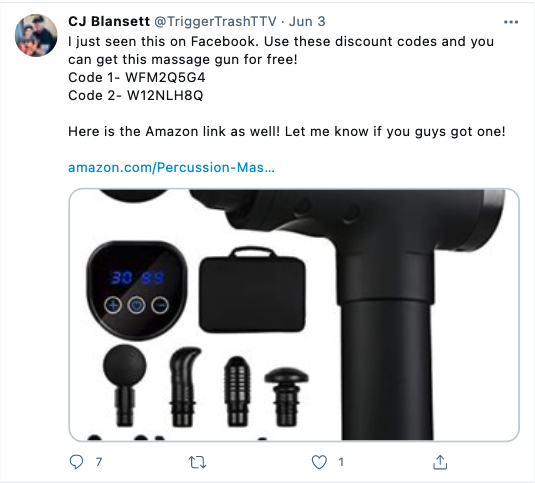
What to do if you come across the Amazon massage gun scam:
- Don’t buy the massage gun or encourage others to do so.
- Alert whoever informed you of these free massage guns of the scam and ask them to take down the post.
- If the post was made by the scammers themselves, report it to the social media platform so it can get taken down.
- Report the scam to Amazon customer service.
Amazon AirPods raffle scam text
Continuing the theme of free things being used as bait, the Amazon AirPods raffle scam is as tempting as it is obvious. It’s a great example of how desirable gadgets can lead the best of us to leave critical thinking by the wayside. Here’s how it works:
- You receive a congratulatory text message that appears to be from Amazon.
- It states that you have won a pair of AirPods (or something similar). All you need to do is follow a link to set up delivery.
- If you follow the link, you’ll be directed to a phishing website. Most likely, it will look convincingly like the real Amazon website. Here, you will be asked to complete a survey to become eligible for the Amazon raffle prize.
- This, of course, is how the scammers steal your sensitive data, including your full address and financial information.
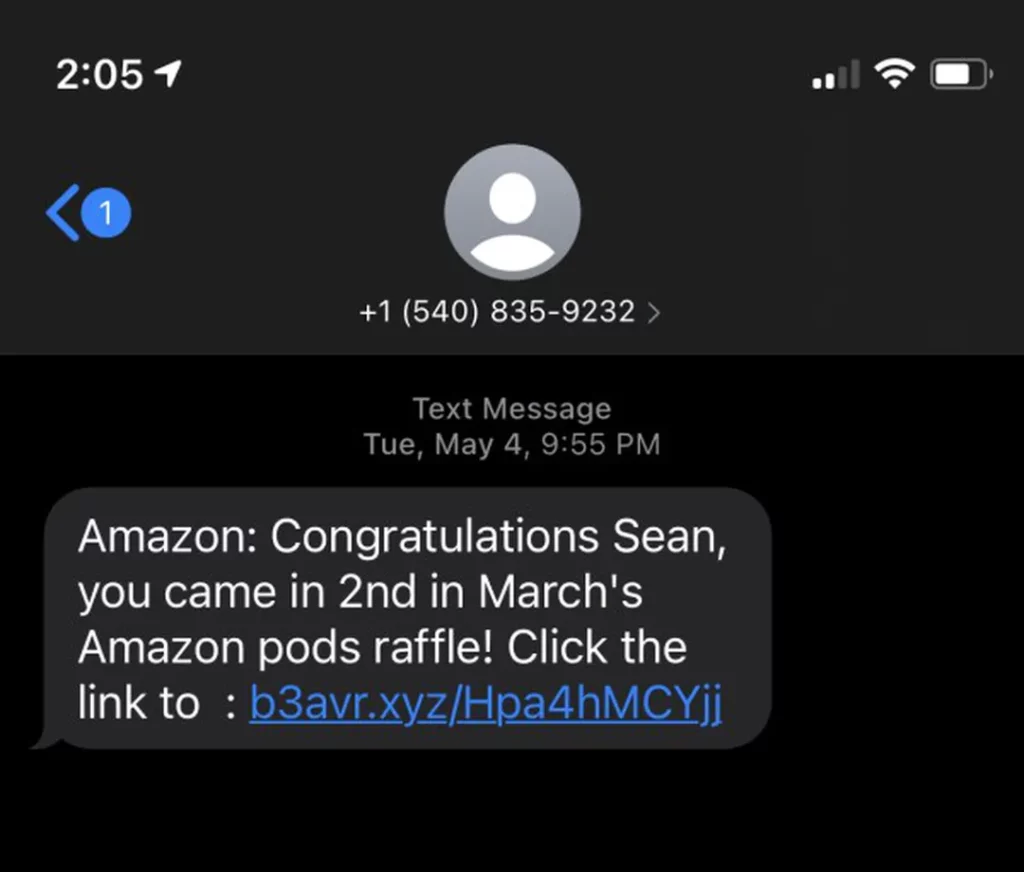
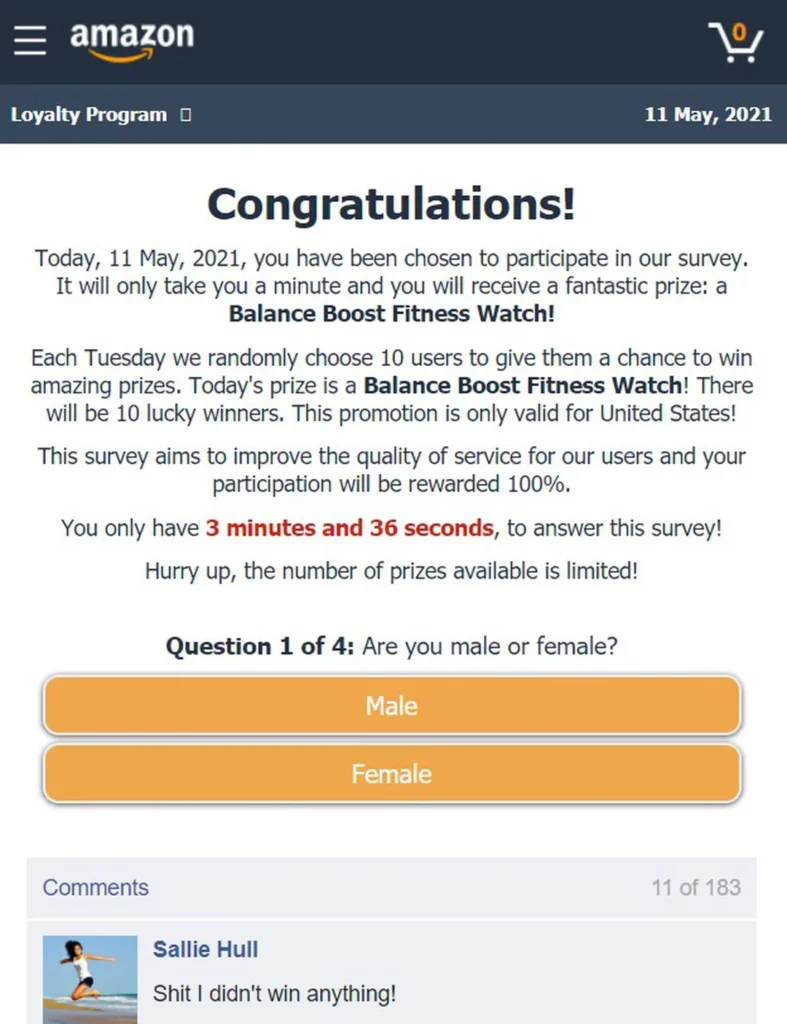
What to do if you come across an Amazon AirPods raffle scam text:
- Set the text aside, log into your Amazon account, and check for any notifications there.
- Amazon even has a webpage dedicated to helping you figure out if such offers are valid.
Amazon free coat scam
This is yet another example of scammers dangling the promise of free things in front of their potential victims, but with a darker twist. As the weather gets colder, many people find they can’t afford warm clothes for their children. Others are looking for holiday gifts. Here are the four main components of the Amazon free coat scam:
- A Facebook post. Someone will post about this amazing offer on Amazon.
- Free coats. They will offer free coats from LINKIOM for little girls aged 10 and under.
- A coupon code. The user claims they were able to purchase a jacket for free using a special promo code.
- A link to the seller listing. The post will usually link to what looks like the legitimate Amazon website.
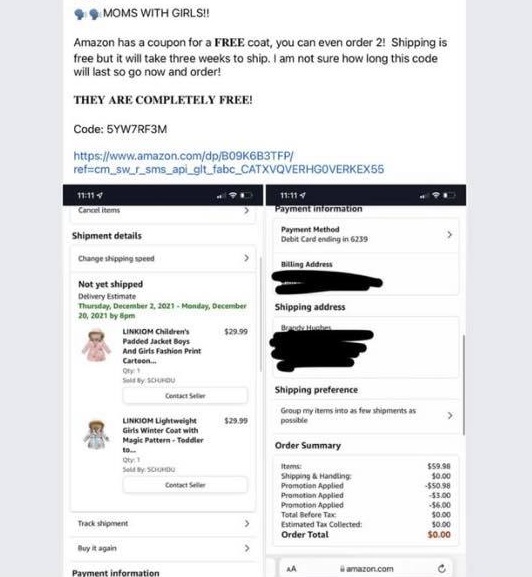
You may or may not actually receive a jacket from this scam. If you do, it’ll be of very low quality. In any case, your personal information will be compromised, putting you at risk of further scams or, in extreme cases, even identity theft.
What to do if you come across the Amazon free coat scam:
- If you know the person who posted about the scam, ask them to delete their post.
- If you don’t, or they refuse to do so, then report the post to Facebook—this is a well-documented scam and the post will be taken down.
Amazon bonus credit text scam
The Amazon bonus credit text scam relies more on your fear of missing out or losing money than it does on your desire for free things. It also very obviously tries to put you under time pressure, literally giving you an expiration date. There are several versions of this scam floating around, but this is how typically works:
- You get a text message telling you that you have unused or unclaimed credit on your Amazon account.
- The message will often address victims by name (scammers can get your name when they get your phone number, possibly from a people search site or other data broker).
- There’s a deadline for you to act: your credit expires in as little as a day.
- Finally, there’s a link that looks nothing like an Amazon URL and leads to a phishing site instead.

What to do if you come across the Amazon bonus credit text scam:
- Put the text message aside—don’t click on the link or reply to it.
- Log into your Amazon account and check for any unused credit.
- Take a screenshot of the text message and note down the scammer’s phone number. Report the scam to Amazon at [email protected].
- Follow our instructions for reporting it to the BBB and FTC as well.
- Finally, block the sender and/or delete the text message.
Amazon anniversary scam
The Amazon anniversary scam depends on the mistaken idea that companies like Amazon, focused as they are on minimizing costs, throw money around by giving away expensive prizes to random people. Here’s how this scam typically works:
- You receive a message on WhatsApp (or Messenger, Instagram, Telegram, or other social media platforms) announcing Amazon’s upcoming anniversary. The message will usually mention gifts and contain a link.
- If you follow the link, you’ll reach a website that looks like an Amazon page. There, you’ll usually be greeted by a congratulatory text explaining that Amazon is giving away hundreds of gifts, such as the Huawei Mate 40 Pro 5G. All you have to do is complete a short survey to claim the prize. But hurry! The offer is valid only until supplies last!
- This survey usually contains four questions about your age, gender, satisfaction with Amazon services, and your smartphone platform of choice.
- Once you submit your survey responses, you’ll be presented with several gift boxes. You’ll usually get 3 chances to pick. If you choose right, you’ll win an amazing gift.
- Of course, you will choose the correct box on one of your tries. As soon as you do, you’ll be prompted to share the message with 20 friends or five WhatsApp groups. This ensures that more people will see the scam, leading to more victims.
- Finally, you can claim your “reward,” but to do so, you’ll have to download a special app where you can enter your full address. Makes perfect sense, right?
Unfortunately, this app will most likely install malware on your device. It can then be used to steal your personal information, hack your devices and accounts, and steal your identity.
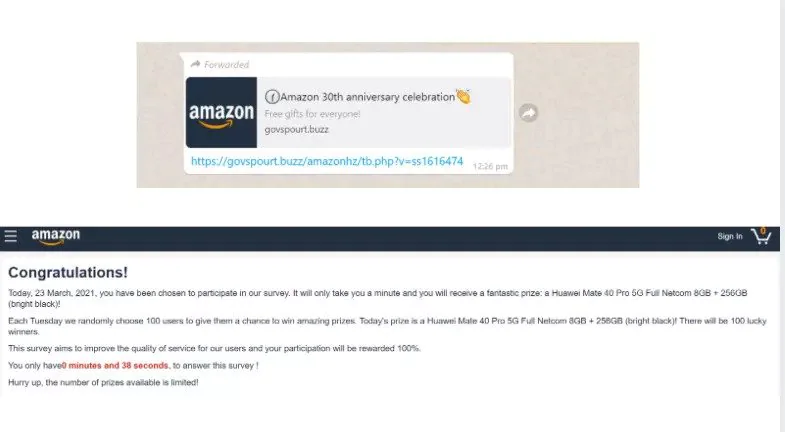
What to do if you come across the Amazon anniversary scam:
- Report the number or flag the post advertising the scam.
- Check the official Amazon website (not via any links) to see if there is a legitimate promotion taking place. Anything not listed on the website is definitely a scam.
- Avoid clicking links and opening attachments. Even if a link appears legitimate, it may be a clever trick that disguises a malicious URL. Some of these attacks may even come from close friends or relatives that have been hacked or tricked into sharing the links.
- Check links using the ScamAdviser search bar if you can’t resist the temptation to follow a link. This tool will let you know if the links or URLs are safe.
AnyDesk Amazon scam
Several of the other scams on this list, like the fake Amazon order confirmation scam, hinge on the scammer gaining access to your Windows or macOS computer. Getting you to install AnyDesk is one of the more popular ways they do this.
To avoid this scam, don’t engage with scammers in the first place. Don’t install anything anyone recommends over the phone. Don’t grant access to your computer to anyone. The only exception here is your school’s or employer’s IT department or a computer repair shop, but only if you called them.
Amazon rewards credit text scam
See the Amazon bonus credit text scam, above. This is the same scam, it’s just sometimes reported under a different name.
Amazon gift card scams
There are many Amazon scams that rely, at least in part, on getting you to purchase Amazon gift cards and sharing the card numbers with the scammers. There’s a long list of these on the Amazon site.
The failsafe, foolproof way to deal with Amazon gift card scams is simply to never use Amazon gift cards for anything other than giving people actual gifts. No legitimate business, and certainly not Amazon, will ever ask you to pay for anything in Amazon gift cards.
Amazon winner of the day scam
This Amazon scam has many faces, but the broad strokes are the same across all of them. It’s another one that plays on our love of receiving free things and adds a little bit of the thrill that comes with winning a contest. Here’s how the Amazon winner of the day scam usually works:
- You get an email, text message, or pop-up window telling you that you’ve won a competition, draw, or sweepstakes you didn’t enter.
- You click on the link to claim your prize and end up giving up personal and financial information, getting hacked, or infecting your device with malware.
What to do if you encounter an Amazon winner of the day scam:
- First and foremost, ignore the congratulatory message. It’s a draw you didn’t enter, how could you possibly have won?
- It’s hard to let an “opportunity” like this slip by, we get it. So log into your Amazon account (directly, not by following a link) and check there. If there’s no notification from Amazon waiting for you, then you know the message was a scam.

Amazon survey scam
This is another scam that targets people who believe that a company like Amazon got to where it is today by being ridiculously generous. It also drastically overestimates the value and scarcity of feedback for a company like this. Amazon will not give you an iPhone to fill out a survey. Here’s how the scam usually works:
- You get a message that contains a link. At first glance, it may even appear legit. However, if you look at the URL, it will either be completely random or disguised as an Amazon link with tiny spelling differences. A real Amazon link will always start with https://www.amazon.com/…
- This wouldn’t be a survey scam without a survey. Once you get to the fake Amazon website, you’ll be prompted to log in to your Amazon account (giving away your credentials), provide sensitive information as part of the survey, and provide your contact details and address for “delivery.”
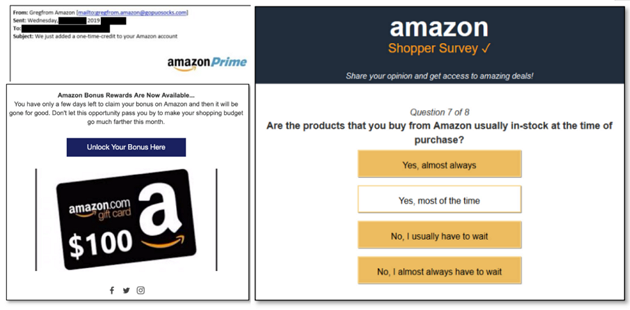

What to do if you come across an Amazon survey scam in the wild:
- Report the number or flag the post advertising the scam.
- Check the official Amazon website (not via any links) to see if there is a legitimate promotion taking place. Anything not listed on the website is definitely a scam.
- Avoid clicking links and opening attachments. Even if a link appears legitimate, it may be a clever trick that disguises a malicious URL. You can never trust links, even if they come from friends or family—they may have been hacked or tricked into sending them.
Brushing scam Amazon
Brushing scams are tricky because you don’t often feel like you’re being scammed. Here’s how they work:
- You get an Amazon package, it’s addressed to you and may even contain quite valuable products, but you didn’t order it.
- It was sent to you by an unethical company that got your name and address somehow (possibly from a people search site or data broker, or directly from the public record).
- They use these unsolicited deliveries to write fake reviews, boosting their reputation and ranking.
Here’s what to do if you find a mysterious package on your doorstep:
- Ask around to make sure it’s not a gift from a friend or family member.
- Report it to Amazon’s Customer Service, including at least one order ID, the number of unwanted packages received, and a photo of at least one shipping label (if you can).
- Consider signing up for an automated personal data removal service like Incogni to keep your data private.
- There’s no need to return the item or items, so enjoy them guilt-free.
Amazon driver chat text scam
Another tricky one, the Amazon driver chat text scam is difficult to handle because it’s often not a scam at all. The Amazon driver chat text you receive may have a suspicious, shortened URL, an instruction to click on it, and de facto time-pressure to act quickly.
These are all red flags, although it turns out the https://a.co domain really is registered to Amazon. So, should you just go ahead and assume these messages are legit? It depends.
If you receive an Amazon driver chat text, do the following:
- Set the text message aside (do not click on the link)
- Log into your Amazon account (directly, not by following the link in the message).
If it was a real driver chat text, then the message will appear on your account, and you can reply from there.

Amazon locked account scam
This is one of those Amazon scams that uses fear to get you acting quickly and thoughtlessly. The key thing to remember with scams like this is that your Amazon account is always the most authoritative source of information. That, and never click on links, whoever they appear to be from. Here’s how the Amazon locked account scam works:
- You get an alarming, if poorly written, message informing you that your Amazon account has been or will soon be locked, for “reasons.”
- The message contains a link to log into, verify, or unlock your account.
- The link takes you to a phishing website where you stand to lose your login credentials, personal information, and payment details.
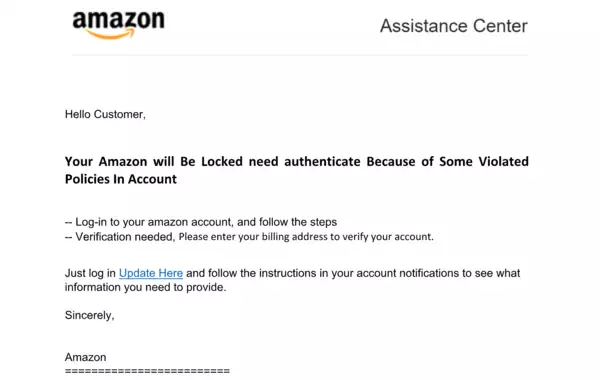
Your Amazon will Be Locked need authenticate Because of Some Violated Policies In Account
Log-in to your amazon account, and follow the steps
Verification needed, Please enter your billing address to verify your account.
Just log in Update Here and follow the instructions in your account notifications to see what information you need to provide.
Sincerely,
Amazon
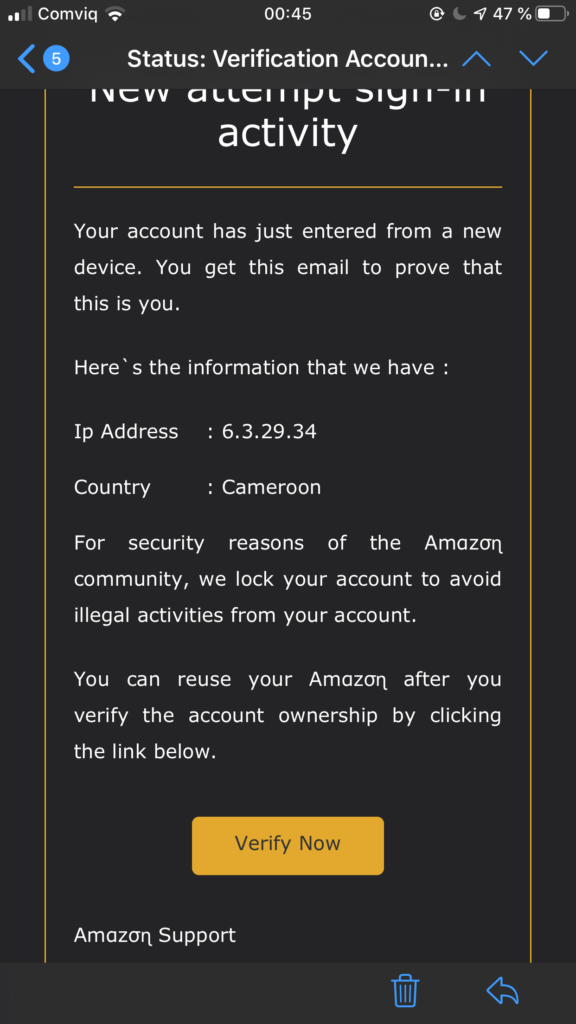
Your account has just entered from a new device. You get this email to prove that this is you.
Here` s the information that we have :
Ip Address : 6.3.29.34
Country : Cameroon
For security reasons of the Amazση community, we lock your account to avoid illegal activities from your account.
You can reuse your Amazση after you verify the account ownership by clicking the link below.
Verify Now
Amazση support
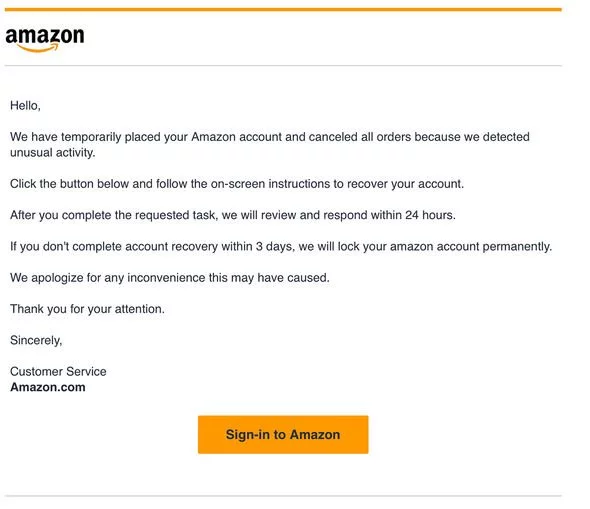
We have temporarily placed your Amazon account and canceled all orders because we detected unusual activity.
Click the button below and follow the on-screen instructions to recover your account.
After you complete the requested task, we will review and respond within 24 hours.
If you don’t complete account recovery within 3 days, we will lock your amazon account permanently.
We apologize for any inconvenience this may have caused.
Thank you for your attention.
Sincerely,
Customer Service
Amazon.com
Sign-in to Amazon
What to do if you come across the Amazon locked account scam:
- Don’t click on anything in the message, even if it addresses you by name.
- Log into your Amazon account. Lo and behold, it isn’t locked.
- Check your notifications—if there’s nothing about suspicious activity or an impending account lockout, then you know that message was a scam.
Amazon credit card scams
Many of the Amazon scams on this list will involve your credit card or debit card at some point. Not all scams end in the victim sending money or banking information to the scammers, but many do. From paying for fake tech support to covering shipping costs for fake prizes, the pretexts vary.
Here’s what to do to avoid scams that involve your credit card:
- Never give out your credit card details over the phone, especially the CCV number on the back.
- Don’t type your card numbers or other details into sites at which you arrived through a link from an email or text message.
- If you believe something is wrong with your payment method on Amazon, then log into the site manually and check there.
- Log directly into your bank or credit card company’s website to check your balance, statements, and transaction history.
Amazon Prime scam
There are a few Amazon scams that zero in on Amazon Prime customers, including the Amazon Prime Video scam and fake order confirmation scam. The more common one involves Amazon scam calls and spam emails being used to net potential victims. Here’s how it works:
- You receive a spam email, robocall, or cold call informing you that you’ve either been charged for an Amazon Prime subscription or that you need to update your payment details to stop your Amazon Prime benefits from being suspended.
- You follow the attached instructions, in which case you potentially execute malicious code on your device and get phished. You may also be connected with someone impersonating an Amazon employee and get phished and possibly instructed to execute malicious code on your device.
Here’s what to do to avoid becoming a victim of the Amazon Prime scam:
- Check any information regarding your Amazon Prime membership directly on the Amazon page (don’t use any links or bookmarks to get there).
- Check any alleged payment issues directly on the Amazon page and directly on your bank’s page (again, type the URLs in manually, don’t use any links or bookmarks).
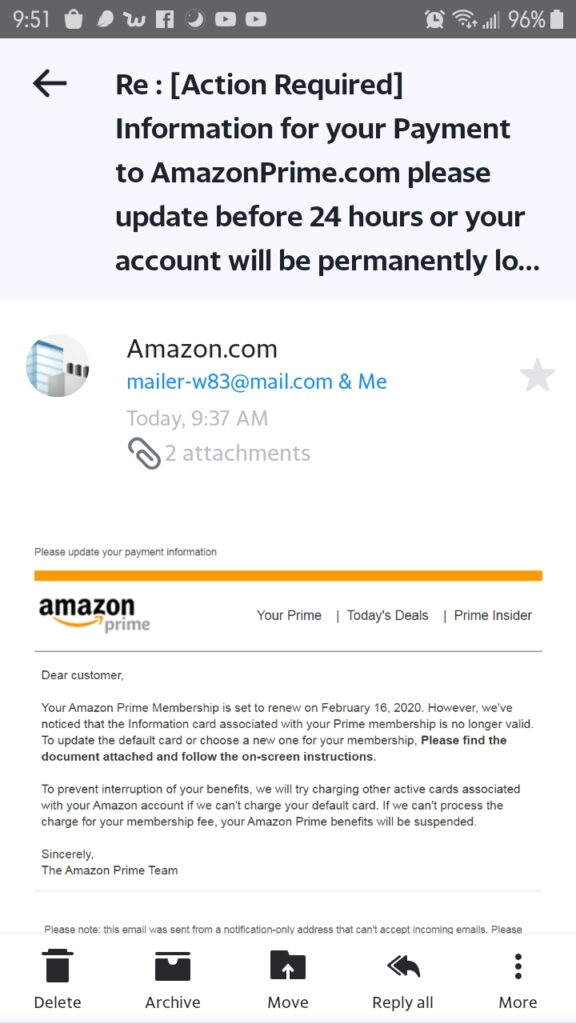
Amazon iPhone scam
This is yet another Amazon scam that uses fear to get you acting quickly, so you don’t feel you have time to stop and think. The twist here is that this scam is typically executed over the phone, making it that much harder to take a breather and take stock. Here’s how it usually works:
- The scam starts when you get a call from someone pretending to be from Amazon or Amazon’s customer support department. Often, this is a robocall. Using robocalls allows scammers to cast a wider net, engaging individual scammers only once someone’s already taken the bait.
- The Federal Trade Commission (FTC) has a recording of a typical example of such a robocall on its website. The script varies only slightly from case to case. The biggest things that change over time are the model and price of the iPhone. Here’s a transcript of the Amazon scam call on the FTC’s site:
“An unauthorized purchase of an iPhone XR 64GB for $749 is being ordered from your Amazon account. To cancel your order or to connect with one of our customer support representatives, please press “1” or simply stay on the line. Please press “1” to connect with our customer support team.”
- Pressing “1” as instructed redirects you to someone impersonating an Amazon employee or contractor. They will then “verify your identity” and “double check” your payment and other financial details before helping you cancel the order. The goal is to gain access to your accounts and money.
What to do if you get an Amazon iPhone scam call:
- If it’s a robocall, simply hang up.
- If it’s a person on the other line, thank them for alerting you and hang up immediately.
- Log into your Amazon account and check for any suspicious purchases.
- If you’re still worried, check your bank for any unauthorized transactions.
- Follow our instructions for reporting the scam attempt with Amazon, the BBB, and FTC.
Fake Amazon order confirmation
This scam’s a little more subtle. Rather than directly encouraging you to click on links by promising freebies or claiming something’s wrong with your account, the fake Amazon order confirmation scam makes you feel like picking up the phone and calling the scammers is your idea. Here’s how it works:
- Out of the blue, you get what looks like an Amazon order confirmation email.
- The email isn’t very well-written, but it informs that an expensive item or items has been or is about to be shipped.
- You notice at least one of two things: you didn’t order the (quite expensive) items and they’re not going to your address.
- The email includes a help-desk or customer-support number, maybe that’s the best way to cancel the order.
- Calling the number ends badly for you, you end up getting phished, charged premium call rates, and/or convinced to install malware on your device.
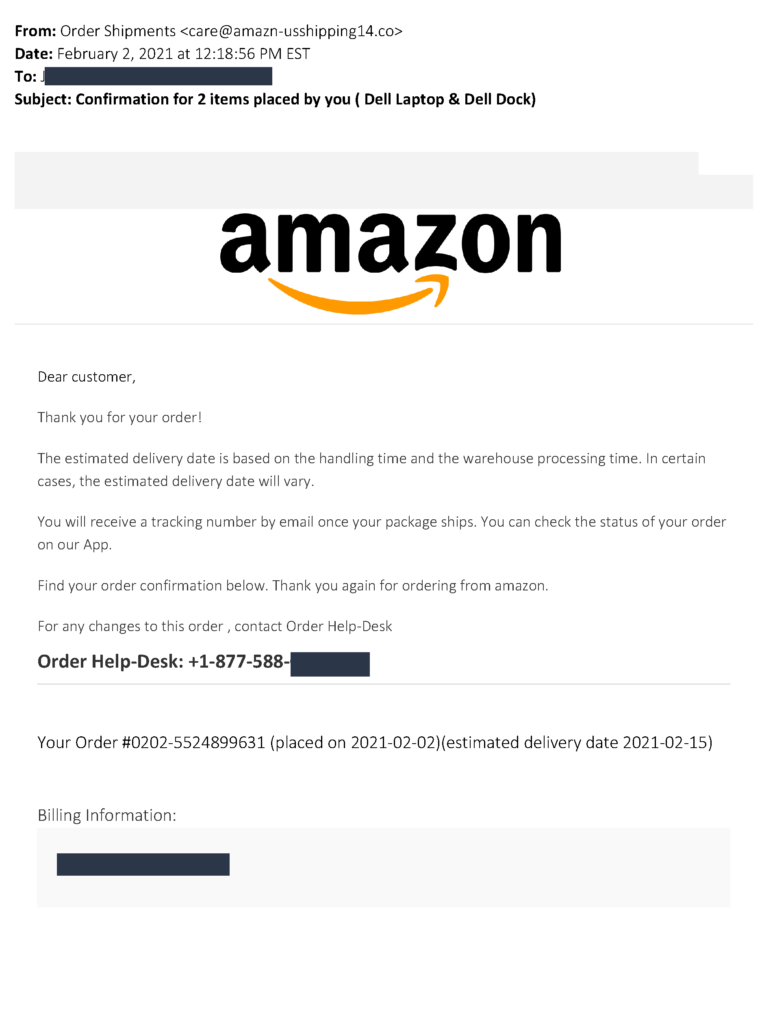
From: Order Shipments <[email protected]>
Date: February 2, 2021 at 12:18:56 PM EST
To: XXXXX
Subject: Confirmation for 2 items placed by you ( Dell Laptop & Dell Dock)
Dear customer,
Thank you for your order!
The estimated delivery date is based on the handling time and the warehouse processing time. In certain cases, the estimated delivery date will vary.
You will receive a tracking number by email once your package ships. You can check the status of your order on our App.
Find your order confirmation below. Thank you again for ordering from amazon.
For any changes to this order , contact Order Help-Desk
Order Help-Desk: +1-877-588-XXXX
Your Order #0202-5524899631 (placed on 2021-02-02)(estimated delivery date 2021-02-05)
Billing Information:
XXXX
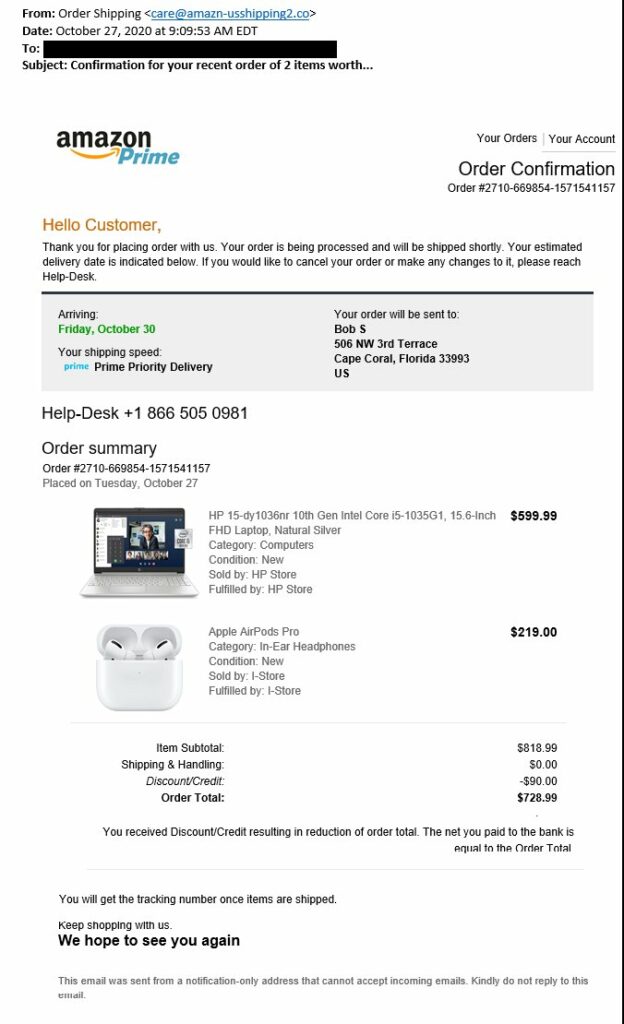
From: Order Shipping <[email protected]>
Date: October 27, 2020 at 9:09:53 AM EDT
To: XXXXX
Subject: Confirmation for your recent order of 2 items worth…
Order Confirmation
Order #2710-669854-1571541157
Hello Customer,
Thank you for placing order with us. Your order is being processed and will be shipped shortly. Your estimated delivery date is indicated below. If you would like to cancel your order or make any changes to it, please reach Help-Desk.
<Shipping details, including a shipping address>
Help-Desk +1 866 505 0981
Order Summary
Order #2710-669854-1571541157
Placed on Tuesday, October 27
<Itemized order summary, including big-ticket items>
You will get the tracking number once items are shipped.
Keep shopping with us.
We hope to see you again
This email was sent from a notification-only address that can not accept incoming emails. Kindly, do not reply to this email.
What to do when you receive a fake Amazon order confirmation:
- Set the email aside and log into your Amazon account. Check your order history there.
- If there’s nothing suspicious there but you’re still worried, then check your transaction history as well.
- Report the email as a phishing attempt (or spam, if that’s the best your email client can do).
- Check out our advice for reporting Amazon scams to Amazon, the BBB, and FTC.
What to do if you come across one of these Amazon scams
Before you do anything else
Take a deep breath. This isn’t an emergency, you have plenty of time to think before you act. The vast majority of Amazon scams rely on putting you under time pressure. Scammers want you to be rushing around with your blinders on—so step back and slow down. Take stock before you move on.
Don’t click on anything
This means links, buttons, attachments—anything. There’s nothing Amazon would send you in a legitimate text message or email that you can’t find on their website. Links in a scam message will most likely redirect you to phishing sites, which are typically designed to get you to enter sensitive information.
Opening an attachment or clicking on a link could also lead to malicious code being executed on your device. Such malware is not likely to do anything obvious like crashing your device. Rather, it’ll probably grab private information already stored on your device or log your keystrokes to get it in real time.
Don’t call any of the phone numbers they give you
Whether you find a suspicious phone number in a phishing message or email, on a fake website, or showing up as a missed call, do not call the number. Ever tried to find a customer support number for Amazon? Most support queries are submitted via chat on the Amazon site or by email.
Amazon will basically never call you. If they were going to call you, they’d also leave a message waiting for you on your Amazon account. Calling a scammer will end badly for you, even if you don’t give them access to your computer or any personal information. At the very least, you’ll have let them know that your phone number is active and in use.
This information is enough to get your number added to scam lists, virtually guaranteeing you’ll be the focus of more phishing attempts in the future. The number could also be a premium-line scam, meaning you’ll be charged an arm and a leg for the call. Search for the number online if you’re tempted to call it.
Don’t reply to any suspicious messages or emails
The same holds true for replying to suspicious text messages and emails. As tempting as it can be to give a scammer a piece of your mind, and as natural as it is to write back asking “who’s this?”, nothing good can come from doing so.
Amazon emails will always come from the amazon.com domain. SMSs will come from the same number as previous messages. If a message you receive requires you to do anything or contains any alarming or clickbait information, check your Amazon account directly by going to www.amazon.com and logging in.
Don’t answer any questions or confirm any info over the phone
It can take a minute to realize you’ve answered a scam call. The best way to avoid phishing scams that rely on you giving up your Amazon account and other sensitive information is to never give out or confirm sensitive information over the phone.
Amazon customer support will never ask for your Amazon password, two-factor authentication code, or bank account information. The whole point of a password and 2FA code is that it’s only for you. Anyone asking for these things is guaranteed not to be a real Amazon representative.
Check your Amazon account
No matter what you’re being told—whether it’s that you’ve won something or that your account has been compromised—the first place you should look is always your Amazon account. There’s nothing that Amazon would want you to know that they wouldn’t put in a notification or message in your account.
If you get a suspicious, enticing, or alarming message or phone call from “Amazon,” simply open a new browser tab, go to www.amazon.com and log in to your account. If there’s no trace of whatever the scammers are telling you there, then you know it’s not true.
What to do if you fell victim to an Amazon scam
Anyone can fall victim to one of these Amazon scams. There’s such a wide variety of tactics used and, often, a lot of pressure to act quickly. It’s easy to get caught off guard and click on something without thinking or get talked into doing something unwise by slick Amazon scammers.
Falling for an Amazon scam isn’t the end of the world. There’s still a lot you can and should do to limit the damage the scammers can do and start repairing any damage they might have already done.
Protect your Amazon account
Change your Amazon password if you entered it while on a phishing website, after clicking on any links or attachments, or if you gave scammers access to your device at any point.
Use a different device and navigate to the Amazon website manually. Links and attachments in a scam message could have executed or installed malware or altered bookmarks on your device.
Protect your finances
If you entered any credit card details or other payment information into a phishing site, downloaded any files, or opened any attachments, then take steps to protect your finances. Contact your bank or credit card company and explain what happened. Keep an eye on your transaction history and credit card statements.
Protect your devices
Many Amazon scams involve scammers getting remote access to your device and/or infecting it with malware. If you followed any links from the email, opened any attachments, or visited any websites while following a scammer’s instructions over the phone, then your device could be affected by malware.
Download reputable antivirus software and run a scan for malware. Do this on any device that might have been affected, whether it runs on Windows, macOS, Android, or iOS. Consult an IT professional if you’re unsure if you can trust your device again. Don’t use the device in the meantime.
Report the scam
Reporting fake Amazon messages and websites as well as Amazon impersonator phone calls can’t turn back time and reverse any damage a scammer has done to you, but it can certainly help protect others. Creating a paper trail of detailed reports now may also help you recover funds and deal with repercussions like identity theft down the line.
Contact Amazon. Its “report something suspicious” customer support page will walk you through the process of reporting your experiences. Amazon has an interest in protecting its customers from fake websites and other phishing attempts.
Report the scam to the social media platform you saw it on. If the scam has a social media component, then report it to the relevant platform. This includes platforms like WhatsApp, Facebook, Instagram, and TikTok.
File a complaint with the Better Business Bureau. Use the BBB’s complaint form to raise awareness about this scam and warn others. This will put some pressure on the scammers and allow you to contribute to a growing pile of evidence mounting against them.
Report fraud to the Federal Trade Commission. The FTC has a website set up on which you can report scams and other kinds of fraud. The FTC can’t follow up on your individual complaint, but it does use such reports to bring cases against those responsible.
Begin the identity recovery process
Identity theft is relatively rare, but if you’ve given a fake Amazon representative remote access to your device, or if you use the same login credentials across multiple online accounts, you’re at risk. The same is true if you’ve given up personal details like your Social Security number.
The Federal Trade Commission’s identity theft portal will guide you through starting the identity recovery process.
Check out similar scam guides:
- Geek Squad Scams
- Telegram Scams
- Cash App Scams
- Wells Fargo Text Scams
- ATT Text Scam
- Venmo Scams
- Snapchat Scams